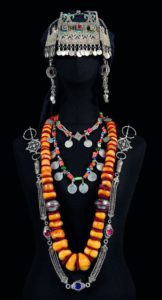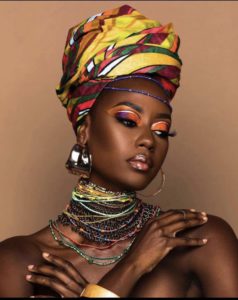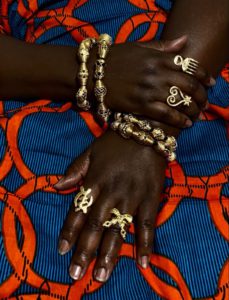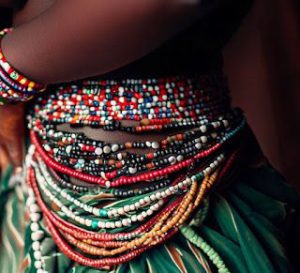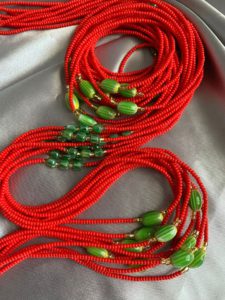The Legacy of West African Waist Beads
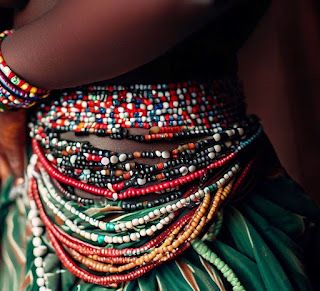
In the rich cultural mosaic of West African life, few adornments carry as much weight, history, and multifaceted meaning as Jigida – the revered waist beads. Far more than simple jewelry, these strands of beads, predominantly found among the Yoruba and Hausa peoples of Nigeria and beyond, are a profound embodiment of beauty, spirituality, and societal roles that have evolved over centuries.
Ancient Roots and Craftsmanship
The tradition of wearing waist beads in Africa stretches back through time, with historical traces suggesting their presence for many centuries. While some theories hint at ancient Egyptian “girdles” as distant relatives, the most direct and continuous lineage of waist bead culture is undeniably rooted in West Africa. Among the Yoruba and Hausa, the practice boasts a particularly well-documented history, with archaeological findings in Nigeria uncovering beads used for adornment, including around the waist, dating back millennia.
Historically, Jigida were crafted from a diverse array of readily available natural materials. Seeds and shells, particularly cowrie shells, were popular choices, often symbolizing wealth, fertility, and even serving as currency. Wood and bone were meticulously carved and polished into various designs, while indigenous glass production, as seen in places like Ile-Ife, provided beautiful and durable beads. More precious materials like stones and metals such as copper, coral, and brass were also incorporated, frequently signaling higher status or specific cultural meanings. The creation of Jigida was a skilled endeavor, involving intricate stringing, knotting, and sometimes the integration of charms or specific patterns, showcasing a sophisticated level of artistry.
A Spectrum of Significance
Jigida are anything but purely decorative. Their historical use is imbued with a wealth of meaning, often serving multiple purposes simultaneously:
Celebrating Femininity and Beauty: At their core, Jigida are a powerful affirmation of female beauty and form. They are worn to accentuate the waist and hips, highlighting a woman’s natural curves and enhancing her physical allure.
Rites of Passage and Womanhood: One of Jigida’s most profound historical roles has been as a symbol of a girl’s transition into womanhood. Young girls are often adorned with waist beads around puberty or the onset of menstruation, signifying their maturity, fertility, and readiness for marriage or new responsibilities. These moments are often accompanied by specific ceremonies, underscoring the beads’ importance.
Sensuality and Intimacy: Deeply intertwined with sensuality, Jigida are often considered private adornments, typically worn beneath clothing and traditionally only revealed to a woman’s partner. They are believed to stir desire and enhance intimate experiences, sometimes being imbued with charms or fragrances to heighten their allure. In some cultures, a husband cutting his wife’s waist beads on their wedding night symbolized the beginning of a new marital phase.
Fertility and Pregnancy: Many traditions link Jigida directly to fertility. Certain beads are believed to promote conception, offer protection during pregnancy, and even facilitate easier childbirth. The subtle, rhythmic sound of the beads can also be part of rituals related to fertility.
Health and Body Awareness: Historically, Jigida served a practical purpose in monitoring the wearer’s physique. As a woman’s weight fluctuated, the fit of her waist beads would change, providing a simple yet effective indicator of weight gain or loss. This made them a traditional tool for maintaining a desired body shape. In some communities, particularly among the Efik, Jigida are placed on female infants from a very young age, believed to help sculpt and accentuate the desired hourglass figure as they grow.
Status and Wealth: The type, material, and sheer number of Jigida worn could readily communicate a woman’s social standing, her family’s wealth, or even her marital status. Rare and expensive materials, or heirloom beads passed down through generations, carried significant prestige.
Spiritual Protection and Charms: In numerous instances, Jigida are believed to offer spiritual safeguarding. They can be imbued with charms or protective elements to ward off evil spirits, attract good fortune, or provide metaphysical solutions to various life challenges.
Jigida Today
While the traditional uses and beliefs surrounding Jigida remain potent, their presence has seamlessly evolved. Today, Jigida are still deeply cherished for their cultural heritage and continue to be worn for many of their historical reasons. However, they are also widely embraced as:
Fashion Statements: Many women, both within and outside West Africa, wear Jigida as a beautiful and distinctive fashion accessory, celebrating their heritage or simply appreciating their aesthetic appeal.
Personal Expression: The choice of colors, materials, and styles often reflects individual personality, personal beliefs, or a vibrant connection to African roots.
Body Positivity: In contemporary contexts, some wear Jigida as a tool for self-love and body acceptance, serving as a constant, gentle reminder of their body’s presence and its natural changes.
In essence, Jigida represents a profound convergence of beauty, spirituality, and social meaning in West African cultures. Their enduring history stands as a testament to the powerful way adornment can convey complex narratives about identity, life stages, and the rich human experience.

